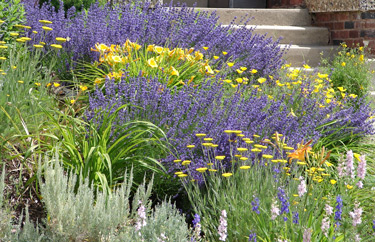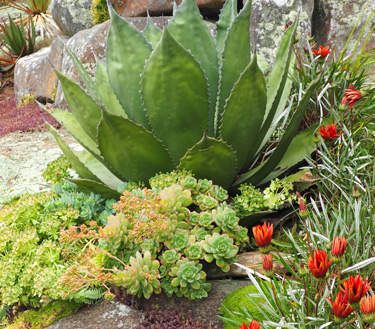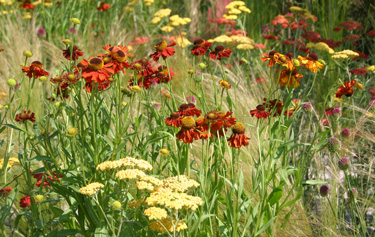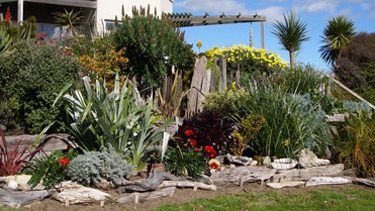Beat the heat!
In the battle to reduce greenhouse gas emissions, planting and good soil care are key things gardeners are well placed to do. And there is plenty we can do to ensure that our gardens continue to thrive under the shifting forces of nature.
Water scarcity over summer is arguably the biggest challenge gardeners face. Warmer temperatures also mean rising populations of pests and diseases, and greater risk of new ones. Fire risk is another concern, as evidenced in hot dry climates, both here and overseas. Whatever the challenge, choosing plants to suit soil and climate has always been a first line of defence.
Surviving the Summer dry
When a plant suffers from water stress its cells collapse, resulting in slower growth and often, irreversible damage to their roots. Even when it seems to have recovered, a once water-stressed plant will often lack vigour and become vulnerable to attack by pests and diseases. Tackling water scarcity is a multi-pronged approach.
Start with shelter. The drying effects of wind are significantly reduced when a windy site is protected with a thick barrier of trees and shrubs. Once established tree roots grow deep into the soil where there is enough moisture to grow without irrigation. Deep-rooted trees and shrubs last much longer without watering than much longer than the likes of lawns and vegetable gardens. Trees and shrubs to provide shelter in a windy climate include: Metrosideros (Pohutukawa), Pittosporum, Olearia, Corokia, Banksia, Coprosma, Griselinia.
Cover the ground. On a hot summer day, a square metre of bare soil can loose two litres of water to the air. The very best way to prevent this is to cover the soil with plants or a blanket of organic mulch. Tough groundcover plants include: Coprosma, Muehlenbeckia, Grevillea, Sedum, Hemerocallis (daylily).
Succulents evolved to survive in the desert, storing water in their leaf and stem cells, with thick waxy skins or furry coats to keep the moisture locked in. Easy-to-grow succulents include: Aeonium, Echevaria, Aloe, Sedum.
Silver foliage almost always indicates a dry tolerant plant. Some favourite silver foliage plants are: Helichrysum, Brachyglottis, Dichondra ‘Silver Falls’, Stachys lanata, Teucrium, Santolina, Pachystegia (Marlborough rock daisy), Stachys lanata (lambs ear), Artemisia, Calocephalus.
Mediterranean herbs born to thrive in dry conditions are go to plants for pots and dry garden beds. These highly aromatic and useful plants include: lavender, rosemary, thyme, sage, borage, oregano, marjoram and French tarragon.
Drought tolerant flowers include some of the brightest in the summer garden. Easy annuals that thumb their noses at hot dry conditions are: Petunia, Calibrachoa, Tagetes (marigold), and Verbena. Dry tolerant perennials include: Achillea, Bergenia, Dianthus, Echinacea, Gaura, Kniphofia, Lychnis, Osteospermum, Penstemon, Phlomis, Sedum, Salvia, Sisyrinchium, Verbena, Pelargonium (aka geraniums).
Clay soil presents challenges in any weather extreme, wet or dry. Good soil drainage is critical for most drought tolerant plants, which can rule them out for a heavy clay soil that bakes dry in summer and remains saturated in winter. Fortunately have some tough all rounders that cope in any soil. These include: Griselinia, Hoheria (lacebark), Sophora (kowhai), Callistemon (bottlebrush), Cistus (rock rose), Coprosma, Leptospermum (manuka), Phormium (flax), Flower Carpet roses, Carex secta (NZ tussock).
Nine ways to save water in the garden
- Mulch to prevent moisture loss, block weeds and improve soil structure.
- Apply compost regularly to improve the water holding capacity of poor soils.
- Train your plants to cope with less water by gradually increasing the days between watering.
- Fix leaky taps, hoses and fittings.
- Plant more shelter.
- Remove weeds.
- Water early in the morning, or in the evening.
- Use trickle irrigation attached to a timer.
- Choose dry tolerant plants.
Reducing the fire risk
In rural New Zealand major forest and grassland fires have become one of the scariest reminders of climate change giving gardeners in hot dry regions another layer of consciousness when planting and landscaping. Fire Emergency New Zealand (FENZ) is urging home owners in at risk areas to plant more fire resistant plants and follow some basic housekeeping advice to help ward off disaster.
Be a tidy gardener. FENZ’s website (fireandemergency.nz) advises, “The best way to protect your house is to reduce the intensity of the fire as it approaches. This can be achieved by creating an area around your house where all flammable material such as scrub vegetation, long, rank grass, leaves and twigs has been removed.” Remove dead branches, and keep shrubs and trees pruned. Fire or no fire most gardens benefit from a once yearly cut back. Trim shrubs after flowering, remove dead branches and prune overgrown trees and shrubs to let in more light. Groom flaxes and grasses and keep hedges neat but don’t leave the trimmings to dry out and accumulate as this is a magnet for embers. Don’t allow dried leaves to accumulate in guttering and drains.
Allow space between plantings. Grouping trees and shrubs in clusters with plenty of open space between each grouping helps slow the spread of fire. You can also increase the vertical space between plants by underplanting trees with low ground covers.
Plant mainly low flammability plants. No plant is completely fireproof but there are many that need higher temperatures before they ignite, so resist burning for longer. Plants, such as succulents with high water content may be able to slow the spread of a fire.
Well-hydrated lawns and low flammability groundcover plants may be damaged or killed by fire but are less likely to contribute to the fuel.
Avoid flammable plants in high risk areas. And keep them well away from the house. Flammable plants include native grasses and those that shed debris (leaves, loose bark, seeds, spent flowers). Also those plants that are fast growing or have a high oil or resin content. These include manuka, kanuka and pines.
Unfortunately many of our most drought tolerant plants are also highly flammable and their benefits need to be weighed up against any fire risk. However, many drought resistant plants are also fire resistant provided they are hydrated and they take less water than other plants to stay hydrated.
Irrigation makes sense in a fire prone area as hydrated plants are the least flammable. Invest in a reliable watering system to ensure water goes where it’s needed most and that plants are watered deeply and efficiently.
Plant in zones. Planting a garden exclusively for fire resistance is not always desirable or practicable. The trick is to concentrate low risk plants in the highest risk areas. Nearest the house concentrate on low growing, low flammability plants and keep them well watered. Avoid planting right up against the house. Keep taller trees shrubs further away from the house.
Mulch with care. Mulching is one of the best ways we can protect the soil and preserve soil moisture. However, some mulching materials present a higher risk than others. Composted wood chips are safer than dry organic materials such as bark. For high risk areas closer to buildings consider rocks, pebbles and pavers to retain soil moisture and block weeds without being a fire hazard. Similarly, tiled patios beat timber decking in high risk areas.
Qualities of low flammability plants:
- Ability to store water
- Extensive root systems
- Limited production of dead material
- Low levels of oils or resins
- Low growing

1-Oct-2019

A xeriscape garden, which does not require additional irrigation to thrive.

Succulents large and small, and gazanias, are ideal for dry locations.

A border of sun-loving, drought tolerant flowers.

Coastal garden

